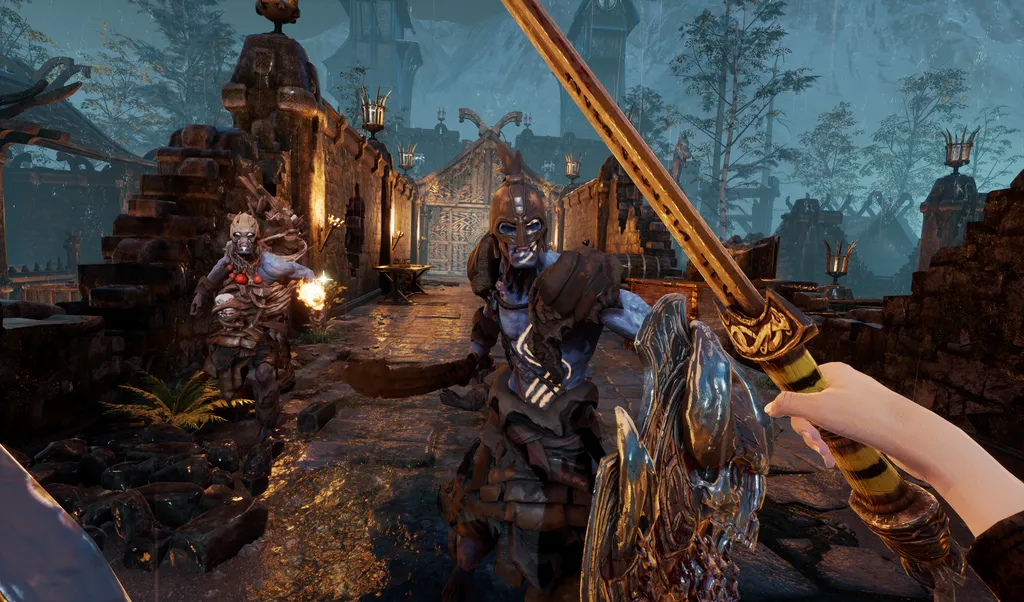Lots of behind-the-scenes tidbits and details were revealed today in a massive oral history report published by Facebook that chronicles the history of Oculus to celebrate the five-year anniversary of the original Rift launch. One of the most interesting details to me is the surprising shift in tone and genre that Asgard’s Wrath went through between its conception and its release.
Asgard’s Wrath
For those unaware, Asgard’s Wrath is a massive VR action-adventure RPG that’s exclusive to the Oculus Rift PC VR store developed by Sanzaru (now owned by Facebook) in which you take control of a Norse God that has the ability to possess mortals and control them directly. The game plays out similar to a Zelda or God of War game in which you explore various realms of Norse mythology, solve puzzles, and fight hundreds of monsters. You can also transform animals into humanoid familiars that fight with you and all have unique abilities to help you on your journey.
It’s a huge, sprawling game that captures the essence of a large-scale AAA quality RPG and puts it into VR with great results. It was the first 5/5 score we ever game here on UploadVR back in 2019 and it’s still my personal favorite VR game to date.
In the oral history report that published today, developers from Sanzaru and Oculus Studios discuss a surprising revelation: the game wasn’t even planned to be an action game at all originally. Not even close.
“Asgard’s Wrath actually started as a Touch-centric demo like VR Sports Challenge,” said Grace Morales Lingad, Creative Director at developer Sanzaru. “It was meant as a Toybox-like demo early on and grew from there… It was more focused on being the god and helping this puny mortal.”
Toybox was a multiplayer Oculus Touch tech demo in which you and another person would stand at a table and play with toys. The toys were intended to encourage interaction so there were building blocks, remote controlled airplanes, and more. That feeling of being a giant looking down at little toys on a table stuck with the developers.
Then along the way it became a tower defense game where you were picking up little
Toybox-size objects and putting them down as your defensive armaments,” said Mike Doran, Director of Production at Oculus Studios. “There’s a couple places where you still see the tower defense game, a couple of boss encounters where you’re firing these giant cannons down on massive armies in the distance. Also, not a lot of people realize that our entire inventory is a series of shelves with tiny little units or objects, and those shelves were originally the UI for selecting towers.”
Once the idea for flipping between God-mode and mortal-mode were introduced, it spiraled from there. They added more features and more concepts on top of everything else, letting you explore more of the world and take control of more types of mortals. Before long, it wasn’t a tower-defense game at all.
“With Asgard’s Wrath, we wanted to make a real-deal, big game,” said Mat Kraemer, Head of Design at Sanzaru. “I’m tired of playing the ten-minute demos and I’m tired of limited movement. I wanted to play a God of War style game. I wanted to play a Zelda style game in VR. I want to make the game that makes you buy an Oculus headset, so when people look at Oculus hardware, they say, ‘I want to play Sanzaru’s next big thing.’ That is what I want to make, and I think as a developer being given the opportunity to do that has been awesome.”
For games similar to what Sanzaru originally envisioned, check out Defense Grid 2 and Brass Tactics. And for more on Asgard’s Wrath, you can read or watch my full Asgard’s Wrath review, beginner tips, and my one-year retrospective from last October that looked back at why the game remains so great for me.
Let us know what you think down in the comments below!


























